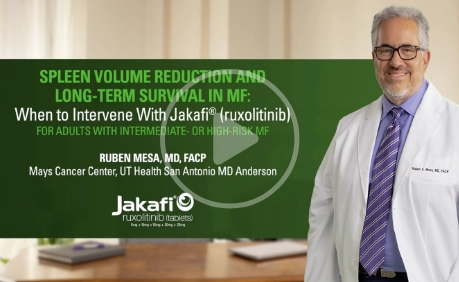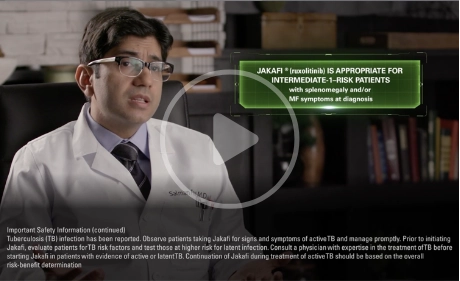For adults with intermediate- or high-risk MF1
Intervene with Jakafi® (ruxolitinib) at diagnosis to help achieve treatment goals in MF

I actively manage my appropriate patients with MF who have any degree of palpable splenomegaly at diagnosis. The support for intervening with Jakafi at diagnosis comes from the COMFORT trials, which showed the impact of Jakafi on spleen volume reduction and overall survival, a secondary endpoint.
Ruben Mesa, MD, FACP, MPN Expert
Indication
Jakafi is indicated for treatment of intermediate or high-risk myelofibrosis (MF), including primary MF, post–polycythemia vera MF and post–essential thrombocythemia MF in adults.
COMFORT-I primary endpoint*
- 42% of patients receiving Jakafi achieved a ≥35% reduction in spleen volume at week 24 vs 0.7% of patients receiving placebo (P<0.0001)1,2
COMFORT-II primary endpoint†
- 29% of patients receiving Jakafi achieved a ≥35% reduction in spleen volume at week 48 vs 0% of patients receiving BAT‡ (P<0.0001)1,3
MF treatment
goals
Consider 3 treatment goals when treating MF: spleen, symptoms, and overall survival
5-year overall survival data
Learn more about the 5-year overall survival data from the COMFORT trials
Earlier vs later initiation data
Learn more about the impact of earlier vs later initiation with Jakafi
Safety
profile
Review the safety data from the COMFORT trials
References: 1. Jakafi [package insert]. Wilmington, DE: Incyte Corporation. 2. Verstovsek S, Mesa RA, Gotlib J, et al. A double-blind, placebo-controlled trial of ruxolitinib for myelofibrosis. N Engl J Med. 2012;366(9):799-807. Supplementary appendix available at: https://www.nejm.org/doi/full/10.1056/nejmoa1110557. 3. Harrison C, Kiladjian J-J, Al-Ali HK, et al. JAK inhibition with ruxolitinib versus best available therapy for myelofibrosis. N Engl J Med. 2012;366(9):787-798. 4. Referenced with permission from the NCCN Clinical Practice Guidelines in Oncology (NCCN Guidelines®) for Myeloproliferative Neoplasms V.2.2023. © National Comprehensive Cancer Network, Inc. 2023. All rights reserved. Accessed June 23, 2023. To view the most recent and complete version of the guideline, go online to NCCN.org. NCCN makes no warranties of any kind whatsoever regarding their content, use or application and disclaims any responsibility for their application or use in any way. 5. Harrison CN, Vannucchi AM, Kiladjian J-J, et al; on behalf of the COMFORT-II Investigators. Long-term findings from COMFORT-II, a phase 3 study of ruxolitinib vs best available therapy for myelofibrosis. Leukemia. 2016;30(8):1701-1707. 6. Data on file. Incyte Corporation. Wilmington, DE.



